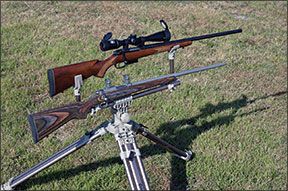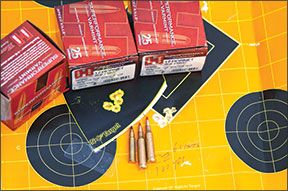Most of us are familiar with 17-caliber cartridges as rimfire ammunition, but the 17 Hornet is a centerfire round that’s only manufactured by Hornady in 15.5- and 20-grain V-Max Superformance loads. But we aren’t offended by being one of the few people buying this round, because the touted box ballistics offer some astonishing numbers. Such as a muzzle velocity of 3650 fps with a drop of only -6.6 inches at 300 yards (200-yard zero). Maybe that’s why Ruger and CZ are taking a chance on chambering rifles for this pipsqueak round, and it’s one of the reasons we were attracted to the cartridge. So much so that we got a $725 CZ-USA 527 Varmint 17 Hornet #03066 and Ruger’s $969 77/17 17 Hornet Rotary Magazine Rifle to test head to head.

Each rifle represented a design well established by their respective manufacturers. The Ruger was built on a Green Mountain color-laminate stock. The CZ stock was Turkish walnut. Both rifles offered a traditional pattern of checkering at the forend and on the pistol grip. Length of pull was equal, measured at 13.5 inches. Stock drop at the comb and at the heel measured the same, and stock pitch was nearly equal. The Ruger had a 3-position safety that allowed the operator to work the bolt, but not the trigger when in its central position. The CZ rifle offered a simpler 2-position on/off safety. Both rifles featured a removable magazine. The Ruger’s 5-round rotary design would go heads up against CZ’s 5-round single column magazine. Each rifle offered a scope mount integral with the receiver and proprietary scope rings. Each gun was fitted with a 24-inch barrel with recessed crown, and when fully loaded, both the CZ and the Ruger weighed more than 7 pounds. Both guns had rubber buttpads. The Ruger finish was matte stainless and the CZ was blued. One final note of comparison was that both the CZ 527 and the Ruger 77/17 17 Hornet rifles demonstrated a noticeable improvement in function between the thirty-fifth and fiftieth rounds. This included magazine fit, feeding, and bolt action, primarily regarding extraction from the magazine. Accuracy from the CZ was remarkable right out of the box, and the Ruger rifle continued to show improvement as its barrel was broken in. Both rifles produced muzzle velocity as listed on the ammunition box, resulting in muzzle energy near 600 ft.-lbs.
To find out how these rifles differed and evaluate this unusual chambering, we began by mounting a 4-16X42 Nikon Monarch BDC scope to test for accuracy from the 100-yard bench. Blessed with tame weather across the range at Houston’s American Shooting Centers, we were able to perform our tests with reasonable uniformity from day to day.
CZ-USA 527 Varmint #0306617 Hornet, $725
The 527-series rifles include seven variations, including a carbine with an 18.5-inch barrel and a full-length rifle with Mannlicher stock and a sloping Bavarian-style comb. Another model has a Kevlar stock that mimics a military precision rifle. But our 527 followed the desires of American shooters for heavier free-float barrels and a straight stock. We tested a CZ-USA 527 VT chambered for 204 Ruger in our June 2013 issue and found two shortcomings. The trigger had creep and grit that did not prevent us from near-MOA accuracy across the. We also found the magazine release awkward and balky feeding.

We can’t say for sure that the handsome Turkish wood stock had anything to do with improving the quality of our 527 17 Hornet, but compared to the earlier VT, this iteration was much improved. The magazine release was easier to find and operate than on the Kevlar model. Also, we liked the magazine chute that acts as a guide, and finding the well without looking was possible from either side of the rifle. The stock was almost neutral for left- or right-handed shooters, and feeding was smooth from the magazine.
At the bench we learned that both the set trigger and the standard trigger were smooth and grit free. Trigger-pull weight was remarkably consistent, measuring 2.25 pounds and 4.0 pounds for the set and standard triggers, respectively. For this reason, we saw no need to adjust the trigger. Accuracy was impressive and consistent. Measurements for the five five-shot record groups measured 0.5, 0.7, 0.7, 0.6, and 0.8 inches.
There were some irritations as well. The action did not allow for loading a single round into the follower. Nor could the magazine be loaded while still in the receiver. Carrying extra magazines would be the only alternative for firing lots of rounds with minimal interruption.
Our Team Said: The 527 Varmint chambered in 17 Hornet was a joy to shoot. It took little effort to deliver -MOA groups at 100 yards, and this may be the most comfortable way to deliver about 600 foot-pounds of muzzle energy we’ve found. We’d be happier if CZ offered a higher-capacity magazine, no matter how long it was. As far as ammo choices, Hornady lists a 15.5-grain NTX round as well as the 20-grain V-Max, but we weren’t able to buy the lighter weight on the open market or from the manufacturer. If both of these situations continue, we hate to think that rifles such as this one could go out of production.
Ruger 77/17 Rotary MagazineRifle K77/17-VHZ #721217 Hornet, $969
Three rifles currently make up Ruger’s 77/17 Rotary Magazine rifle catalog. The $900 77/17 RM 17 HMR is slightly smaller than its brothers and is built with an American walnut stock and alloy steel receiver. The remaining two rifles are very nearly twins. In fact, the outer dimensions of the 77/17 17 Hornet does little to distinguish it from the $969 VMBBZ 77/17 17 HMR rifle tested in the September 2013 issue. Both rifles have 24-inch barrels and stretch about 43.25 inches end to end. The metal finishes are both matte stainless, and as much as we liked the Black Laminate stock of the 17 HMR rifle, we think the Green Mountain Laminate stock on the 17 Hornet showed real depth and color without looking unnatural.
Our 77/17 had some very helpful features built in. The scope mount integral with the receiver offered two set positions to the rear of the ejection port for greater versatility. Scope rings were provided. The rifle can be ordered with either 1-inch or 30mm scope rings. The rotary box magazine was helpful because it didn’t spoil the underside of the rifle by sticking out and limiting how and where the rifle can be supported. Aside from the magazines, the only apparent difference from the 17 HMR was the bolt and how it released. To remove the bolt from the rimfire model required the shooter to press downward on a sheet-metal lever hugging the left side of the receiver inside a relief. The owner’s manual for the 17 Hornet rifle was too generic when describing the bolt-release lever: “Depress the bolt stop on the left side of the receiver,” with no illustration. In this case the bolt stop was hidden at about 7 o’clock beneath the bolt itself. Once found, it worked just fine.
The Ruger magazine was a little difficult to load initially. The method for loading ammunition into the rotary follower required the shooter to get the spool inside the magazine body to spin, and at first it was a little stubborn, accepting and then pushing out the rounds. During the first few attempts, the bolt didn’t always pick up a round. But after about the fourth loading, the rotary movement became easier. As you can guess, this also affected cycling, at least at the start. After a few loadings, we rated the speed and smoothness of the bolt action and cycling of the Ruger to be superior to the CZ. But like the CZ, the Ruger rifle only accepted rounds directly from the magazine. Extra magazines cost $35.
Elsewhere, the Ruger’s trigger registered a consistent 5.5 pounds on our Chatillon trigger-pull gauge. It was not user adjustable. While this may seem needlessly heavy, the action was nevertheless crisp and free from creep or grit, without a hint of free motion or take-up. From the bench our shots of record measured 0.9 inch, 1.2 inches, 1.1 inches, 1.1 inches, and 0.80 inch, in that order. Velocity from the Ruger’s 24-inch barrel produced about 16 fps greater velocity than the CZ’s.
Our Team Said: The bolt action was tight and clean. We were able to cycle the 77/17 17 Hornet faster than many of the other Ruger rifles we’ve tried. Despite early failures to feed, we liked the rotary magazine for its ability to disappear into the receiver and not interfere with support. The trigger was consistent, which minimized the effect of it being heavier than necessary. With our one choice of ammunition, this was a 1-moa high-velocity rifle.
Written and photographed by Roger Eckstine, using evaluations from Gun Tests team testers. GT

























